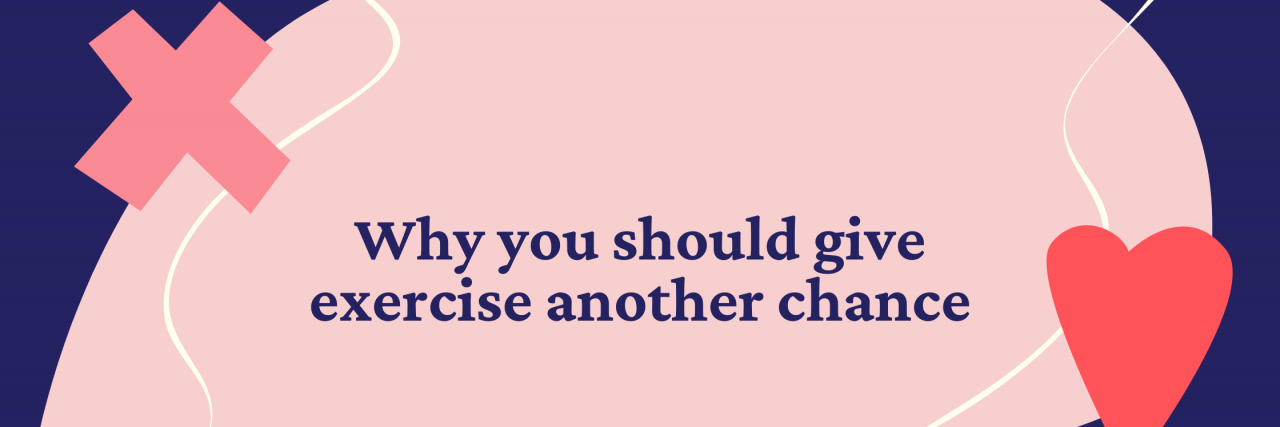Exercise. Workout. Movement. Fitness. Training. Gym.
If you are like me, you don’t have a positive association with these words. Maybe they inspire sadness, anger, guilt, anxiety (my go-to).
That’s because mostly these words have been used against us:
- As a way to dismiss our symptoms
- As a solution to all our problems (insert separate rant here)
- As highlighting a limitation or weakness
- As a guilt trip
Between the interactions with doctors and non-spoonies, we shut down, avoid or even actively hate any mention of these concepts.
• What is Ehlers-Danlos Syndrome?
• What Are Common Ehlers-Danlos Syndrome Symptoms?
That’s where I was — some mix of hatred for exercise and shame/anxiety about not partaking in physical activity.
Among other things, I have been diagnosed with Ehlers-Danlos syndrome. Basically, my body doesn’t make collagen well; collagen is in all your connective tissues such as joints and skin. So I am hypermobile, have no proprioception (i.e. sense of where I am relative to other objects), have no coordination, and injure easily. Not exactly how you describe a star athlete.
My adaptation over the years was to be sedentary, which was bad for my mental and physical health. There is so much research on how good exercise is for chronic pain and pretty much everyone.
And I knew that, but it is easy to justify inactivity. I had an arsenal of excuses or logical fallacies. My favorite was the “exception to the rule”: if my body is this different from other people’s, maybe exercise isn’t good for me.
But I didn’t see an alternative — most physical activities were unattainable and … undesirable (i.e. painful).
Why would I do something that hurts while I am doing it, after I am done, and provides no long-term or short-term value?
Let me clarify — the prior statement isn’t true. But I convinced myself it was… for years.
I have recently gotten in the habit of exercising three times a week, and honestly: it’s a game-changer.
No, I’m not Superwoman (yet), I haven’t miraculously dropped my extra pounds, nor has it drastically changed my pain levels. I’m assuming the physical benefits are coming, which would be a welcome addition.
But what has changed is the way I look at my body and myself as a whole.
- My pain serves a purpose. When I am sore after a gym day, I know it was because of the work I put in the day before. And I know the soreness is a sign that I am getting stronger. If I am going to hurt either way, it might as well be for a reason other than my body sucks.
- I default to what my body can do, not what it can’t. It gives me fuel to fight against some of my negative thoughts. Rather than “You’re so weak,” I have evidence to fight back with: “You did an extra plank this week — you are making some major improvements.”
- I feel (somewhat) in control of my body, or at least its general trajectory. I don’t have control over my body, but I do have control over the effort I put into conditioning it. For example, I may only be able to use a lightweight for a particular exercise, but I can control how many reps I do. Even if I have a particularly “hurt-y” day, I can know that I am still improving my health overall.
- When I do it right, I feel as good or better than before I worked out. OK, not 5 minutes after I finish. But once I shower and eat some food, I actually end up doing more (chores, cooking, writing, etc.) than on days I don’t exercise. This isn’t always the case; I am still mastering the right balance of effort, controlled movements, and not overexerting. However, even on the high pain days where I only stretch, I still feel accomplished and more relaxed than when I started.
Exercise will (probably) not magically solve all your chronic symptoms. But if it is an option you previously rejected, I encourage you to think again.
I recently wrote articles with tips on how to actually start exercising and how to get through a workout, with practical tips on how to start your routine and be successful during your workout.
Enjoy exercising!
This article is part of a series on Exercising With Chronic Illness. Read more here:
This story originally appeared on Paiges of Progress.

